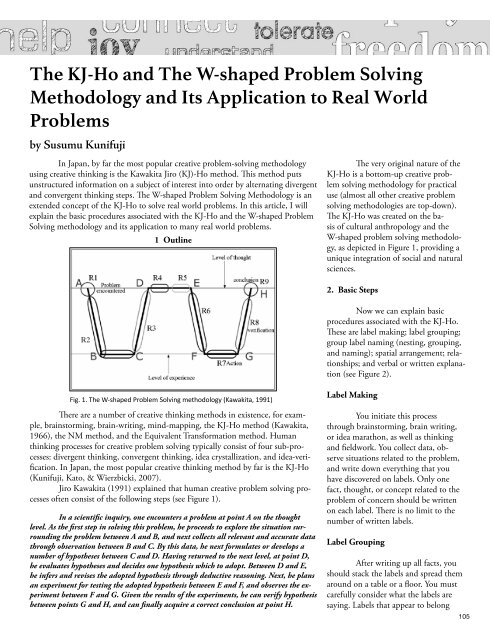Torrance Journal for Applied Creativity
TorranceJournal_V1
TorranceJournal_V1
You also want an ePaper? Increase the reach of your titles
YUMPU automatically turns print PDFs into web optimized ePapers that Google loves.
The KJ-Ho and The W-shaped Problem Solving<br />
Methodology and Its Application to Real World<br />
Problems<br />
by Susumu Kunifuji<br />
In Japan, by far the most popular creative problem-solving methodology<br />
using creative thinking is the Kawakita Jiro (KJ)-Ho method. This method puts<br />
unstructured in<strong>for</strong>mation on a subject of interest into order by alternating divergent<br />
and convergent thinking steps. The W-shaped Problem Solving Methodology is an<br />
extended concept of the KJ-Ho to solve real world problems. In this article, I will<br />
explain the basic procedures associated with the KJ-Ho and the W-shaped Problem<br />
Solving methodology and its application to many real world problems.<br />
1 Outline<br />
The very original nature of the<br />
KJ-Ho is a bottom-up creative problem<br />
solving methodology <strong>for</strong> practical<br />
use (almost all other creative problem<br />
solving methodologies are top-down).<br />
The KJ-Ho was created on the basis<br />
of cultural anthropology and the<br />
W-shaped problem solving methodology,<br />
as depicted in Figure 1, providing a<br />
unique integration of social and natural<br />
sciences.<br />
2. Basic Steps<br />
Now we can explain basic<br />
procedures associated with the KJ-Ho.<br />
These are label making; label grouping;<br />
group label naming (nesting, grouping,<br />
and naming); spatial arrangement; relationships;<br />
and verbal or written explanation<br />
(see Figure 2).<br />
Fig. 1. The W-shaped Problem Solving methodology (Kawakita, 1991)<br />
There are a number of creative thinking methods in existence, <strong>for</strong> example,<br />
brainstorming, brain-writing, mind-mapping, the KJ-Ho method (Kawakita,<br />
1966), the NM method, and the Equivalent Trans<strong>for</strong>mation method. Human<br />
thinking processes <strong>for</strong> creative problem solving typically consist of four sub-processes:<br />
divergent thinking, convergent thinking, idea crystallization, and idea-verification.<br />
In Japan, the most popular creative thinking method by far is the KJ-Ho<br />
(Kunifuji, Kato, & Wierzbicki, 2007).<br />
Jiro Kawakita (1991) explained that human creative problem solving processes<br />
often consist of the following steps (see Figure 1).<br />
In a scientific inquiry, one encounters a problem at point A on the thought<br />
level. As the first step in solving this problem, he proceeds to explore the situation surrounding<br />
the problem between A and B, and next collects all relevant and accurate data<br />
through observation between B and C. By this data, he next <strong>for</strong>mulates or develops a<br />
number of hypotheses between C and D. Having returned to the next level, at point D,<br />
he evaluates hypotheses and decides one hypothesis which to adopt. Between D and E,<br />
he infers and revises the adopted hypothesis through deductive reasoning. Next, he plans<br />
an experiment <strong>for</strong> testing the adopted hypothesis between E and F, and observes the experiment<br />
between F and G. Given the results of the experiments, he can verify hypothesis<br />
between points G and H, and can finally acquire a correct conclusion at point H.<br />
Label Making<br />
You initiate this process<br />
through brainstorming, brain writing,<br />
or idea marathon, as well as thinking<br />
and fieldwork. You collect data, observe<br />
situations related to the problem,<br />
and write down everything that you<br />
have discovered on labels. Only one<br />
fact, thought, or concept related to the<br />
problem of concern should be written<br />
on each label. There is no limit to the<br />
number of written labels.<br />
Label Grouping<br />
After writing up all facts, you<br />
should stack the labels and spread them<br />
around on a table or a floor. You must<br />
carefully consider what the labels are<br />
saying. Labels that appear to belong<br />
105


